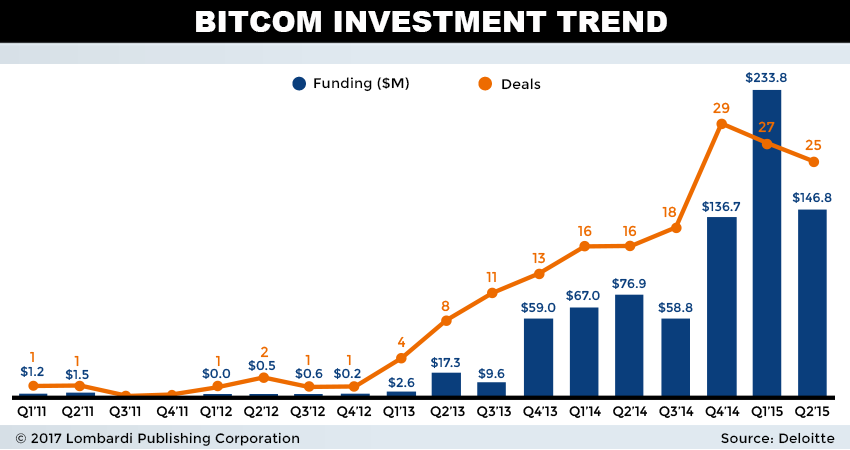Blockchain Technology in Banking System Will Change How We Spend Money
Back in the early 1990s, when the Internet was first gaining public traction, the public at large failed to grasp how disruptive it would turn out to be.
Of course, you had the early adopters and business leaders who were giddy about its potential; they turned out to be correct. But the general public’s enthusiasm didn’t really peak until the Tech Bubble fully matured. This is where we are today in regards to blockchain technology. The impact on the financial sector is about to bubble over. And, just like in the 1990s, the public is only now catching on to what the enthusiasts and early adopters already know. Understanding these dynamics is the key to unlocking the investment potential that blockchain equities and currency provide.
First off, how does the blockchain work? For readers new to the topic, here’s a quick primer on what all the buzz is about. Bitcoin (BTC) will be the focus, since it’s by far the largest and most developed of the blockchain subtypes.
Bitcoin is an open-source public ledger called the “block chain.” This ledger contains all transactions ever processed, allowing Bitcoin users to verify every transaction. Purchases or sales are protected by digital signatures assigned to the sending addresses, allowing users full control over sending bitcoins from their own Bitcoin addresses. In essence, it’s digital money that can be transferred to any other digital wallet without some of barriers inherent to traditional banking structures.
Let’s take an example of how this process works. If person “A” wants to send money to person “B,” the transaction is sent to the counterparty represented as a “block.” This block of information is then sent to every computer database on the blockchain network. Those in the network can then prove that the transaction is valid if it conforms to a certain methodology (previously agreed upon by the network). Once approved, the block can be added to the network and the transaction is verified as valid. The money then gets transferred to person “B.” No middle agents, no barriers. Plus there’s cost efficiency.
Even if all this sounds great, you may be wondering why financial institutions are jumping on board. Don’t they already have a monopoly on the way financial services are run? Yes they do, but increasing cost competition in financial services is forcing banks to rethink their bulkier business model. The back office is traditionally one of the big banks’ largest profit eaters, and blockchain technology promises to eliminate much of that cost. The days of $30.00 wire transfers and big delays are coming to an end, as blockchain systems could soon perform the same function faster, and less expensively. Blockchain in the financial sector was initially viewed as a competitive threat, but attitudes have changed.
The real profit opportunity for investors is understanding why blockchain technology is poised to break through. And, to exemplify this, we draw certain unmistakable parallels to the Internet. Far from just a currency (although it possesses exceptional qualities as such), examples of blockchain usage are springing up everywhere. It’s currently being tested in voting, intellectual property, financial exchanges, derivatives clearing, legal databases, leasing contracts, ridesharing, and more. Applications are seemingly endless, with major consortiums attempting to develop a “killer” app which commercializes the potential.
Similar to the Internet, blockchain technology is designed without a central command structure. Each layer is defined by governable protocols decided by the developers, which allow parties to build products and services. A key innovation driver of blockchain technology—seen in the Internet’s early rise—is the limitless publication of information without permission. With the development of a few killer apps, blockchain technology can evolve into an e-commerce machine; not just in the payments realm, but with any program which can be written into the block.
The Internet, as we know it, took decades to develop, with each milestone leading to a more rapid development of the next. Ethernet standardized the way in which computers transmitted information between networks, and protocols such as Transmission Control Protocol (TCP) and Internet Protocol (IP) were used to regulate how data packets were routed between computers. Routers, network switches, and fiber optic cable were later developed to handle the immense requirements of increased data usage.
In a similar vein, blockchain technology is at the stage where its incredible potential is undeniable, yet technological hurdles remain. For example, Bitcoin transaction times are taking up to 13 minutes on average, with a significant percentage taking over 30 minutes. This is due to the one-megabyte size limit on blocks built into the system. In order to really generate mainstream appeal, transaction confirmation times need to be reduced by raising the storage limit. The instant transaction standard has already been established, so there’s no putting that back into the bottle.
In time, these hurdles should be solved. Bitcoin may morph into something different but, like e-mail or web browsers, significant tenets of the technology will exist. After all, it’s not just currency we’re talking about. The blockchain can support a variety of applications, including smart contracts, asset registries, and many new types of transactions that go beyond financial and legal uses.
That’s what true utility looks like, and it’s completely unique to this technology.
What Is the Impact of Blockchain on the Financial Sector?
If we take the word “transaction” to mean an “agreement, contract, exchange, understanding, or transfer of cash or property that occurs between two or more parties and establishes a legal obligation,” blockchain technology is the only medium which can accomplish all these things simultaneously. That’s a big deal in the financial industry, where legalese dominates.
Already, blockchain financial services companies have sprung up, providing competition to the banks. Companies like BTCJam and Safello AB are providing customers with many of the same services offered by traditional banks. Loans and self-directed investment plans are part of the package. It barely registers as significant competition to the banks right now, but that could change rapidly once governments accept Bitcoin as legal tender.

Japan has done just that. They’ve officially recognized Bitcoin as a legal currency. The Japanese Cabinet signed a law recognizing virtual currencies like Bitcoin as money, thus removing a huge potential obstacle to growth. Citizens can now make payments, conduct transfers, and purchase goods with the full confidence that Bitcoin is recognized as legal tender, and fully legal within the framework of the law. This could provide the springboard needed for a fickle public to finally take Bitcoin seriously as an equal to fiat currency. Such recognition will act to bring Bitcoin out of the fringes and into the mainstream consumer consciousness. Russia is following the same path as well. (Source: “Bitcoin in Japan: Officially Recognized in April; Asset or Expense?,” Cryptocoins News, March 29, 2017.)
This is just a precursor to optimism exhibited by the financial community in some high-level survey numbers.
According to a September 2015 report by the World Economic Forum, 73.1% of 800 survey respondents (executives and experts from the information and communications technology sector) expect that, by 2025, a government will allow taxes to be paid via Blockchain technology, and that 10% of global gross domestic product (GDP) could be stored on a Blockchain. In case you weren’t aware, global GDP is roughly $76.0 trillion annually, so that’s roughly $7.6 trillion stored on the blockchain. (Source: “Deep Shift Technology Tipping Points and Societal Impact,” World Economic Forum, last accessed May 8, 2017.)
With that amount of capital stored on the blockchain, perhaps it’s no surprise that business leaders Jeremy Liew and Peter Smith have given Bitcoin a price target of $500,000. The two have devised their prediction, in part, by dividing an ordained market cap of $10.0 trillion and dividing by 20 million bitcoins outstanding. Voila, they come up with a 2030 Bitcoin price target of $500,000 and a user headcount of 400 million worldwide. Those numbers don’t seem far-fetched if the World Economic Forum numbers are prescient.
The price target also takes the following three assumptions, which seem wholly reasonable.
- By 2030, Bitcoin’s average value per user (AVU) grows to $25,000 from today’s $2,515.
- The Bitcoin supply becomes 20 million coins, which will be close to the total, since only 21 million bitcoins can ever be in circulation
- There is an average Bitcoin price of $1,000.
As of this writing, the price is around $1,300/BTC. Should these predictions come to pass, the market penetration within the financial system would be on par with national fiat monetary systems throughout the globe. Bitcoin (and most likely other blockchain currencies) would be completely embedded into the fabric of mainstream banking, forever.
The stock market is also poised for more blockchain use. The Japan Stock Exchange and the NASDAQ are among a few stock markets around the globe that are testing blockchain technologies in order to streamline their back office systems. There are also a few blockchain technology stocks that investors can acquire, but most are listed on secondary stock exchanges, and are not particularly investment-worthy. Nonetheless, blockchain technology is not just advancing in the banking sector, but everywhere that derivative trading and clearing takes place.
The blockchain impact on the financial sector will be profound. This is being reflected in the price of Bitcoin and Ethereum, which have soared to new heights. It’s not the ground floor, but it’s not too late to invest in this technology if you believe it will achieve great things.






